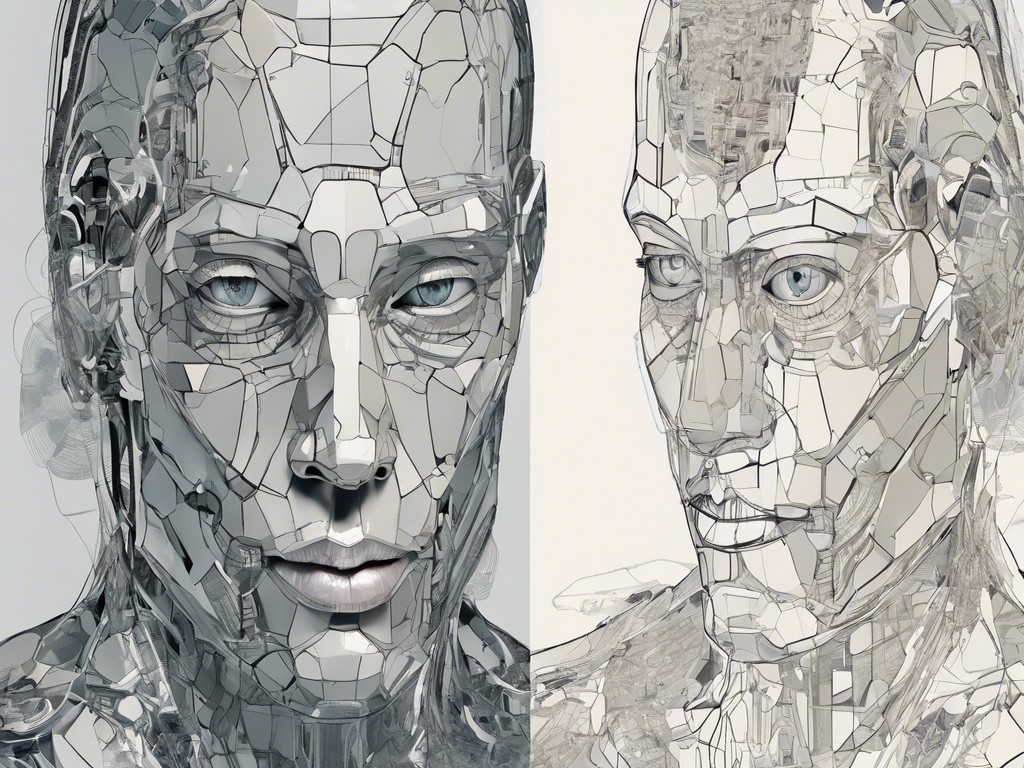In the rapidly changing world of technology, the combination of artificial intelligence (AI) with human capabilities has become an important area of research. AI human makes the limits of human intelligence by following thinking skills such as learning, reasoning, and problem-solving.
The importance of understanding this synergy lies in its potential to change how tasks are executed, varying from strategic games like chess and Go to difficult decision-making and data analysis processes.
AI’s combination of human features like emotional intelligence, creativity, and awareness represents a major advancement toward the development of robots that understand and interact with their environment in a way similar to humans.
The article will examine the development of artificial intelligence (AI) and how it affects human intellect, stressing the strengths and weaknesses of existing AI systems. It will examine how artificial intelligence (AI) is affecting many different domains, including how industries are changing due to chatbots, machine learning algorithms, and neural networks.
It will also cover the serious hazards and ethical questions raised by AI, including privacy concerns, security concerns, and the possibility that AI could outperform humans in cognitive tasks.
Lastly, the conversation will touch on the potential applications of AI and human intelligence in the future, taking into account both the difficulties and the opportunities that lie ahead. Readers will navigate the complicated dynamics of artificial and natural cognition by gaining insights into the link between AI and human intellect through this thorough examination.
The Evolution of AI and Human Intelligence
AI's Capabilities and Limitations
Tasks where AI excels:
AI excels in large-scale data analysis, pattern recognition, and repetitive procedures. AI systems, for example, can quickly process and analyze large information, discovering trends and anomalies that humans may miss. AI systems can recognize minute patterns in imaging data that indicate health risks, making this skill vital in industries like medical diagnosis. AI is particularly effective in fast-paced contexts like financial trading, where milliseconds may make or break profits.
Areas Where AI Struggles:
Despite its capabilities, AI has considerable hurdles when dealing with activities that need common sense, contextual awareness, or creative problem-solving. AI systems lack human-like flexibility and adaptability, making them less effective in dynamic settings that require an understanding of social cues and ethical judgments.
AI may give technically accurate but culturally incorrect solutions, highlighting its failures in understanding details. AI’s lack of creativity and emotional intelligence makes it unsuitable for positions requiring feelings, such as hospital care or customer service. Understanding and responding to human emotions is vital.
Ongoing Challenges and Research:
The subject of AI is constantly growing, with researchers solving a number of crucial difficulties to improve the capabilities of AI systems. Improved learning algorithms allow AI to adapt to new situations without requiring lengthy retraining. Researchers prioritize ethical AI development, providing that systems are trustworthy and transparent.
Research focuses on developing AI systems with advanced learning and reasoning abilities, similar to human minds.
This involves efforts to provide AI with a type of ‘common sense’ and the capacity to interpret the world in a way that is more aligned with human thinking

Impact on Different Fields
Healthcare
AI is transforming healthcare by improving data management and diagnostic procedures. For instance, AI applications such as Amazon Health Lake enable healthcare professionals to structure and query vast amounts of unstructured data, improving access to critical information.
AI-driven tools, including machine learning and natural language processing, are instrumental in areas like cancer diagnosis, where they process clinical records to match patients with appropriate clinical studies efficiently.
Furthermore, AI assists in managing chronic diseases such as kidney disease by evaluating images and predicting patient trajectories, offering a new level of precision in personalized medicine.
Finance
In the financial sector, AI’s impact is profound, significantly altering how services are delivered. Institutions use AI for several objectives, ranging from boosting customer service via AI-powered chatbots to risk management and fraud prevention. For example, JPMorgan employs AI in numerous operational facets, including marketing and complex transaction analyses, to maintain a competitive edge.
Additionally, AI’s role in regulatory compliance is becoming crucial, automating data collection and decision-making processes, thereby increasing efficiency and accuracy in financial reporting and compliance.
Education
AI integration in education is altering traditional teaching techniques and creating a more individualized learning environment. AI technologies provide adaptive learning systems that personalize instructional content to specific student requirements, increasing student engagement and effectiveness.
AI-powered tutoring systems, for example, give individualized help by adjusting to the speed and learning preferences of each learner. Furthermore, AI techniques are utilized to create and modify curriculum designs, ensuring that they are relevant and responsive to changing educational needs.
Creative Arts
The creative arts have embraced AI, creating new opportunities for artistic expression and innovation. AI algorithms help artists generate basic art conceptions and make detailed refinements, allowing them to experiment with new creative methods.
This partnership between human artists and AI not only speeds the creative process but also offers a unique dimension to art, challenging traditional concepts of ownership and originality. AI’s potential to assess and develop new artistic aspects has led to the birth of various art forms and approaches that were previously unfathomable.
Ethical Considerations and Risks
Bias and Fairness Issues
While AI systems are transformational, they have the basic danger of maintaining current social biases, potentially leading to discriminatory behavior. AI might be biased due to historical injustices or non-representative data gathering. These biases can have a significant influence on decision-making processes in vital areas such as healthcare, policing, and recruiting, unfairly disadvantaging particular populations.
To address these concerns, data handling and model training methods must be thoroughly scrutinized to ensure fairness and minimize bias.
Privacy Concerns
The integration of AI in numerous industries presents serious privacy problems. AI’s ability to collect, analyze, and infer personal data on a scale never before seen has the potential to harm individual privacy. Monitoring, identification, and data aggregation are examples of risks that might convert AI into a tool for aggressive data activities, compromising human liberty and independence.
Privacy Enhancing Technologies (PETs) such as differential privacy and uniform encryption are critical in protecting data privacy in the age of AI.
The Role of Human Monitoring Human
Oversight is necessary in the AI ecosystem to guarantee accountability and ethical alignment. It serves as a vital safeguard against the unbridled autonomy of AI systems, especially when it comes to choices that have big moral ramifications. AI decision-making processes are kept under human supervision by upholding human-in-the-loop procedures, guaranteeing that AI systems uphold moral principles and serve the public interest.
Maintaining transparency, avoiding biases, and defending human values in AI operations need ongoing oversight and the inclusion of ethical norms throughout the AI lifecycle.
The Future of AI and Human Intelligence
The field of artificial intelligence (AI) and human intelligence is developing at a never-before-seen rate, with breakthroughs that might completely reshape expectations for productivity, creativity, and social standards.
In the journey ahead, the fusion of AI with human ingenuity holds the potential for transformative breakthroughs across various domains, yet it also presents challenges that necessitate a balanced approach and thoughtful consideration of long-term implications.
Potential Advancements
Generative AI stands at the forefront of this evolution, offering tools that augment human creativity and innovation. These AI systems excel in generating and refining ideas, increasing the specificity of concepts, and even combining different ideas to forge novel solutions. The true potential of generative AI lies not in replacing human efforts but in assisting individuals and teams to create solutions previously unimaginable.
This democratization of innovation can empower a wider range of people to contribute their ideas, overcoming barriers that have historically limited participation due to challenges in communicating concepts in written or visual form.
Balancing AI with Human Creativity
The potential for collaboration between AI and human creators is highlighted by the application of AI in creative areas, especially in the media and entertainment sectors. AI technologies have shown promise in automating workflows, personalizing content, and even generating original works.
However, the essence of this collaboration is to enhance, rather than replace, human creativity. For instance, in the visual effects industry, AI can create photorealistic digital environments, but it is the emotional depth and narrative vision of human artists and directors that bring these creations to life. This synergy between AI’s computational capabilities and human sensibility defines a new frontier in creative expression.
Long-Term Effects on Society
The growing incorporation of AI into our daily lives raises significant questions about the long-term societal repercussions of AI development. Artificial intelligence (AI) poses ethical and privacy concerns despite its numerous benefits, which include enhanced productivity and the creation of novel solutions. Widespread AI use might exacerbate cybersecurity vulnerabilities, enlarge economic disparities, and need preventive regulation.
It is essential to comprehend and deal with these long-term effects if we are to direct AI research toward moral, sustainable, and value-driven goals. Stakeholders must give precedence to openness, address any biases, and guarantee that AI systems are developed with a human-centric perspective.
In summary, rather than being a zero-sum competition,
the future of AI and human intelligence will be a joint effort that makes use of both the advantages of artificial and human cognition. We can meet the difficulties and take the possibilities that lie ahead if we recognize the possible improvements, strike a balance between AI and human innovation, and carefully analyze the long-term ramifications for society.
It will need a coordinated effort from academics, decision-makers, and the general public to make sure that AI complements human strengths and promotes innovation, equality, and fairness in the world.
Conclusion
As we take stock of our trip across the vast domains of artificial intelligence and human intellect, we are reminded of the enormous influence AI has on our lives as well as the innate synergy between technical development and human creativity. We get closer to comprehending artificial intelligence’s role in enhancing human potential by investigating its evolution, capabilities, and ethical issues.
The insights into a range of industries, including healthcare, banking, education, and the creative arts, highlight how disruptive AI is and how careful development is required to fully realize its potential.
Anticipating the future, the combination of AI with human creativity offers a stimulating picture in which creative solutions to difficult problems arise as a result of this collaboration.
It is critical that we strike a balance between ethical considerations and technological developments as we traverse this ever-changing terrain, ensuring that AI development is informed by a human-centric perspective. We are at the dawn of a new era when artificial intelligence (AI) not only enhances human skills but also promotes a more inclusive, egalitarian, and creative society. Let’s embrace this joint endeavor.
FAQs
Can AI Surpass Human Intelligence?
AI systems are designed to assist and augment human capabilities rather than replace them. They require human guidance to navigate complex decisions, emphasizing the role of AI as a supportive tool rather than a substitute for human intellect. Responsible and ethical application is key to leveraging AI effectively.
Is Achieving Human-Level Intelligence a Goal of AI?
Indeed, the overarching aim of AI development is to create computer programs capable of solving problems and achieving objectives in the real world as efficiently as humans do. This pursuit drives much of the research and development in the field of artificial intelligence.
Has AI Attained Human-Level Intelligence?
Modern large language models have demonstrated human-level performance in various benchmarks, including reading comprehension and visual reasoning, as highlighted in Stanford University’s 2024 AI index. This signifies a significant milestone, showing that AI can match human capabilities in specific areas.
What Connects AI to Human Intelligence?
AI and human intelligence are interconnected through the concept of cognitive processing and learning. Just as the human brain is capable of intelligent thought and decision-making, AI systems are designed to emulate these capabilities. This parallel allows AI to be applied across numerous sectors to automate and enhance tasks or processes, demonstrating its potential as a powerful tool for human advancement.


